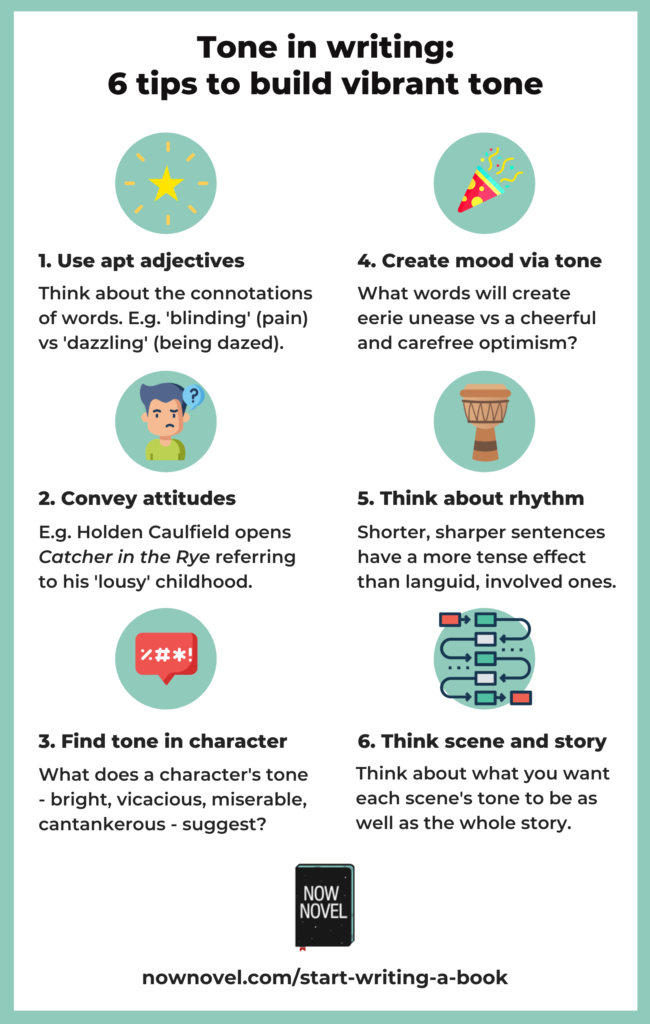Crafting a consistent tone in writing can make your message more impactful. Learn how to establish tone effectively in writing.

Image courtesy of via DALL-E 3
Table of Contents
Welcome, young writers! Have you ever read a story that made you feel happy, sad, or excited? Well, the way an author makes you feel through their writing is all thanks to something called “tone.” Tone is like the author’s voice, and it helps convey emotions and mood in a story or article. Today, we’re going to explore the world of tone in writing and learn how to establish a consistent tone in our own work.
What is Tone?
Tone in writing is the way an author expresses their attitude or feelings towards a subject. It’s the vibe or mood that the words create for the reader. Just like how different voices can make you feel different emotions when someone speaks to you, tone can do the same in writing.
Why Tone Matters
Imagine if a story suddenly switched from being funny to serious without any warning. It might confuse you, right? That’s why having a consistent tone is essential in writing. It helps maintain clarity and keeps readers engaged, making sure everyone understands the emotions and messages you’re trying to convey.
Understanding Different Tones
Exploring the various types of tones in writing can be an exciting journey into the world of emotions and imagination. Different tones can change the way readers perceive a piece of writing and feel while reading it. Let’s delve into the different tones that authors can use to create engaging and captivating content.
Friendly Tone
A friendly tone in writing is like having a warm conversation with a close friend. It makes readers feel welcomed, comfortable, and involved in the story or message being shared. Authors use a friendly tone to connect with their audience on a personal level and create a sense of camaraderie. When you read something with a friendly tone, it feels like the author is speaking directly to you, making the experience enjoyable and relatable.
Serious Tone
A serious tone in writing is important for conveying deep emotions, sharing profound thoughts, or discussing critical topics. When the tone is serious, readers understand that the subject matter is significant and requires careful consideration. Serious writing can evoke feelings of respect, contemplation, and introspection. Authors use a serious tone to address important issues, deliver essential information, or convey heartfelt messages that leave a lasting impact on the readers.
Funny Tone
A funny tone in writing is like a burst of laughter that brightens your day. Authors use humor and wit to entertain their audience, make them smile, and keep them engaged throughout the reading journey. A funny tone can be lighthearted, playful, or downright hilarious, depending on the style of the author. When readers encounter a piece of writing with a funny tone, they often find themselves chuckling, giggling, or bursting into laughter, enjoying every moment of the humorous experience.
Choosing the Right Tone
When it comes to writing, selecting the appropriate tone is crucial for effectively conveying your message to your audience. Tone sets the mood of your writing and determines how your readers will perceive your work. Let’s explore how to choose the right tone based on your audience and the purpose of your writing.
Knowing Your Audience
Before you start writing, it’s essential to consider who will be reading your work. Understanding your audience’s age, interests, and preferences will help you determine the most suitable tone. For instance, if you are writing for children, a friendly and engaging tone would be ideal to keep them interested. On the other hand, if your audience consists of professionals, a more formal tone might be more suitable.
Purpose of Writing
The reason behind your writing also plays a significant role in selecting the right tone. Are you trying to inform, persuade, entertain, or express emotions? Each of these purposes requires a different tone. For example, if you are writing a persuasive piece, a confident and assertive tone would be effective in convincing your audience. If your goal is to entertain, a light-hearted and humorous tone could keep your readers engaged.
Maintaining a Consistent Tone
Before you start writing, think about the tone you want to use. Decide if you want to be friendly, serious, or funny. Planning your tone ahead of time can help you stay consistent throughout your writing.

Image courtesy of www.nownovel.com via Google Images
Revising for Consistency
After you finish writing, go back and read what you wrote. Check if the tone stays the same from beginning to end. Make changes where needed to ensure your tone remains consistent.
Using Language to Set Tone
When you write, the words you choose can have a big impact on how your writing feels. The words you pick can help create the mood and feeling you want to convey. For example, if you want your writing to sound friendly and inviting, you might use words like “welcome,” “warm,” and “friendly.” On the other hand, if you want your writing to sound serious and important, you may choose words like “significant,” “crucial,” and “essential.” By selecting the right words, you can set the tone for your writing.
Sentence Structure
Not only do the words you choose matter, but the way you put them together in sentences can also influence the tone of your writing. Short, snappy sentences can create a sense of urgency or excitement, while long, flowing sentences can make your writing feel more relaxed and thoughtful. By playing around with sentence lengths and structures, you can adjust the tone of your writing to suit your purpose.
Examples of Tone in Popular Books
In the popular children’s book “Charlotte’s Web” by E.B. White, the author uses a friendly tone to create a warm and inviting atmosphere for young readers. The interactions between Wilbur the pig and Charlotte the spider are portrayed in a kind and gentle manner, making the characters relatable and engaging. The author’s choice of words and dialogues conveys a sense of friendship and camaraderie, making the story heartwarming and enjoyable for children.

Image courtesy of www.linkedin.com via Google Images
Serious Tone Example
An example of a serious tone can be found in the non-fiction book “Anne Frank: The Diary of a Young Girl.” Anne Frank’s diary, documenting her experiences during the Holocaust, is written with a somber and reflective tone. The author’s words are poignant and heartfelt, conveying the gravity of the historical events she lived through. The serious tone of the book evokes emotions of empathy and understanding in readers, highlighting the importance of remembrance and reflection.
Funny Tone Example
In the humorous book “Diary of a Wimpy Kid” by Jeff Kinney, the author adopts a funny tone to entertain and engage young readers. The misadventures of middle schooler Greg Heffley are narrated in a light-hearted and comical way, incorporating witty humor and relatable situations. The funny tone of the book adds a sense of levity to the story, making it appealing and enjoyable for kids looking for a laugh.
Practicing Setting Tone
One fun way to improve your writing skills is by practicing setting different tones in your writing. Try writing short paragraphs in different tones to understand how each tone conveys a different mood and emotion. For example, write a paragraph with a friendly tone to make your readers feel welcomed and at ease. Then switch to a serious tone to convey important information or deep thoughts. Lastly, experiment with a funny tone to inject humor and keep your readers entertained.
Tone Switching
Another great exercise to enhance your writing abilities is to practice tone switching. Take a paragraph you have written and try changing its tone. For instance, if the original paragraph had a serious tone, switch it to a friendly or funny tone. This exercise will help you understand how tone influences the overall feel of your writing and how subtle changes can completely alter the reader’s experience. By practicing tone switching, you will develop a better grasp of how to set and maintain tone effectively in your writing.
Common Mistakes to Avoid
One common mistake that writers make is having an inconsistent tone throughout their writing. When the tone shifts abruptly, it can confuse readers and disrupt the flow of the piece. To avoid this, make sure to plan your tone before you begin writing and stay true to it throughout the piece. If you find yourself switching tones, go back and revise to ensure a consistent voice.

Image courtesy of inkandcopy.com via Google Images
Misinterpretation of Tone
Another pitfall to watch out for is the misinterpretation of tone by readers. Sometimes, certain words or phrases can be misunderstood, leading to a tone that doesn’t align with your intentions. To prevent this, carefully choose your words and consider how they may be perceived by your audience. Be clear and deliberate in your language to convey the exact tone you desire.
Conclusion
In this article, we have delved into the world of tone in writing and explored the significance of maintaining a consistent tone throughout a piece of writing. Just like how a person’s voice conveys emotions and mood, tone in writing sets the atmosphere for the reader. By following the tips and guidance provided, you can elevate your writing and engage your audience effectively.
Remember, the key to successful writing lies in understanding your audience and purpose, selecting the appropriate tone, and staying consistent from start to finish. Plan your tone ahead of time, revise for consistency, and pay attention to your choice of words and sentence structures to ensure your message shines through clearly.
As you continue on your writing journey, keep practicing setting different tones, be mindful of common mistakes to avoid, and explore the diverse tones used in popular books for inspiration. By honing your skills in establishing tone, you will captivate readers and convey your message with impact.
So, whether you aim to inform, entertain, or persuade, mastering the art of setting tone in your writing will undoubtedly elevate your work and leave a lasting impression on your audience. Embrace the power of tone, and let your words resonate with clarity and purpose.
Want to turn these SEO insights into real results? Seorocket is an all-in-one AI SEO solution that uses the power of AI to analyze your competition and craft high-ranking content.
Seorocket offers a suite of powerful tools, including a Keyword Researcher to find the most profitable keywords, an AI Writer to generate unique and Google-friendly content, and an Automatic Publisher to schedule and publish your content directly to your website. Plus, you’ll get real-time performance tracking so you can see exactly what’s working and make adjustments as needed.
Stop just reading about SEO – take action with Seorocket and skyrocket your search rankings today. Sign up for a free trial and see the difference Seorocket can make for your website!
FAQs
What is the most important thing about tone?
Tone is incredibly important because it sets the mood and emotions of your writing. Consistency in tone helps your readers understand your message clearly and keeps them engaged throughout your piece. It’s like having a friendly conversation with your readers, where you want to make sure they feel comfortable and understand what you’re trying to say.
Can I use more than one tone in my writing?
While it’s generally recommended to stick to one tone to maintain clarity and consistency, there are instances where using multiple tones can be appropriate. For example, if you’re writing a story where different characters have distinct personalities, using different tones for their dialogues can enhance the storytelling. Just make sure the shifts in tone are purposeful and don’t confuse your readers.
How do I know if my tone is right?
To ensure your tone is suitable for your audience and purpose, it’s helpful to read your writing aloud or have someone else read it to you. Pay attention to how the words make you feel and whether they match the emotions you want to convey. Additionally, consider the feedback you receive from others to see if they interpret your tone in the intended way. Adjusting your tone based on these observations can help you refine and improve your writing.







